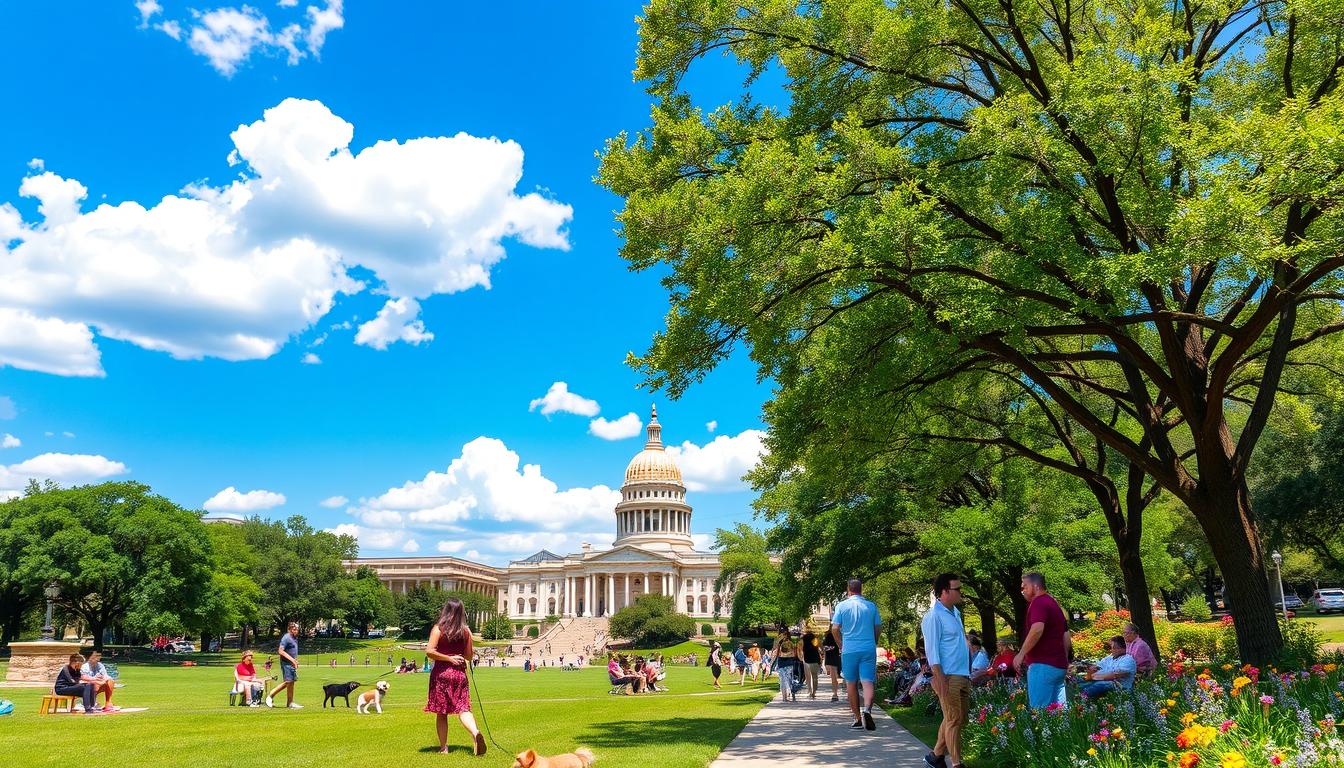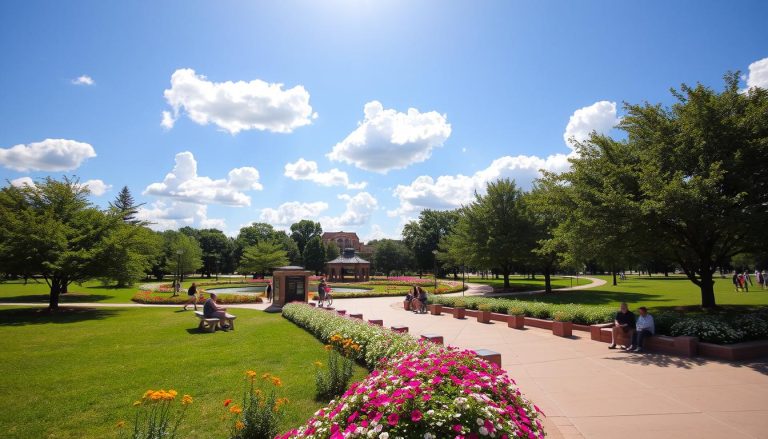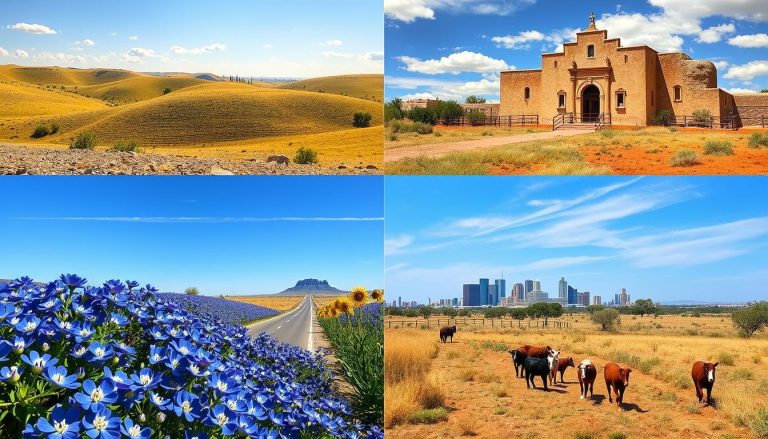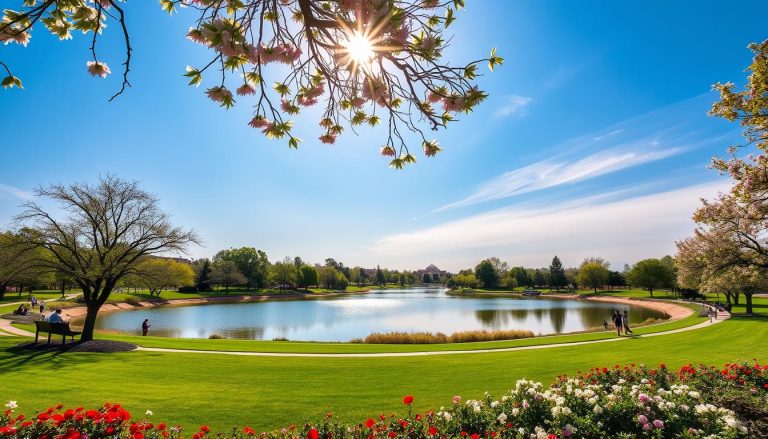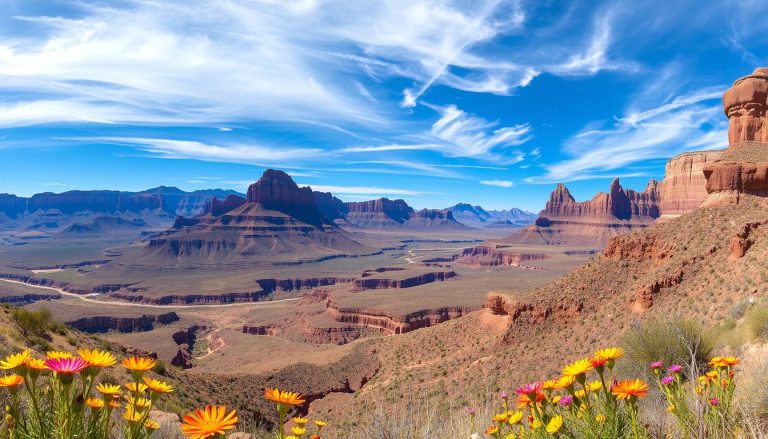Are you planning a trip to Austin, Texas? The weather is key when planning your trip. Austin’s climate can affect your outdoor fun and overall trip. So, which months are the best for a great visit?
Key Takeaways
- October is generally the best month to visit Austin, with daytime highs in the 80s F and infrequent rain.
- March and April offer near-perfect weather, with typical high temperatures in the 70s and 80s F respectively.
- Summer months like July and August can be brutally hot, with temperatures often exceeding 100°F (38°C).
- Rainfall patterns throughout the year can impact outdoor activities and events, so planning accordingly is crucial.
- Austin’s mild winters provide a respite from the intense summer heat, making it an attractive destination during the holiday season.
Understanding Austin's Humid Subtropical Climate
Austin, Texas, is often thought to have a desert-like climate. But, it actually has a humid subtropical climate. This means hot summers, mild winters, and lots of rain all year.
Temperature Patterns Throughout the Year
Summers in Austin can get very hot, with temperatures over 100°F (38°C) in July and August. Winters are mild, with highs around 60°F (16°C). This makes it great for outdoor fun all year.
Humidity and Rainfall Overview
Austin’s climate is known for its rain. May is the wettest month, with 5.03 inches of rain. The humidity can make it feel muggy, especially before rain.
The area’s geography, like the Edwards Aquifer, affects water sources. Barton Springs Pool, for example, stays at 68°F (20°C) all year.
Climate Misconceptions
Some people think Austin’s climate is drier than it is. But, its location in the Texas Hill Country and its 700-foot elevation make it more moderate. It’s not as dry as some think.
Knowing about Austin’s climate helps visitors plan better. They can enjoy the area’s many seasonal activities and natural spots.
Spring in Austin: A Wildflower Paradise
As winter fades and the air warms up, Austin turns into a lively place. The Texas Hill Country around the city is full of outdoor fun and natural beauty. This beauty blooms in the spring.
The spring in Austin starts cool in March and gets warmer by May. This change brings a beautiful wildflower show. The Lady Bird Johnson Wildflower Center is a top spot for nature lovers. It was founded in 1982 by Lady Bird Johnson and has over 5,000 native plants and flowers.
May is the wettest month in Austin, with over four inches of rain. The rain helps the area’s plants grow, including bluebonnets and Indian paintbrushes. These flowers color the hills in amazing ways.
The Bluebonnet Highway is a scenic 80-mile drive through the Texas Hill Country. It shows off many wildflower types. The Willow City Loop, a 13-mile route, is also great for seeing bluebonnets and other flowers.
Spring in Austin is perfect for outdoor adventures and wildflower blooms. But, people with allergies should watch out for high pollen levels, especially from oak trees.

“Spring is the best time to visit Texas, particularly from mid-March to mid-May.”
Summer Heat and Outdoor Activities
Summer in Austin is very hot, often over 100°F (38°C) in July and August. It’s key to manage the heat. Afternoon thunderstorms offer a cool break from the sun.
Managing the Texas Heat
People go to Barton Springs Pool to stay cool. It’s always 68°F (20°C). Lake Travis and other lakes are also great for escaping the heat.
Events start early or late to dodge the heat. This way, everyone can enjoy Austin’s summer activities without getting too hot.
Popular Summer Destinations
- Barton Springs Pool
- Lake Travis
- Barton Creek Greenbelt
- Zilker Park
- Rainey Street District
Water Recreation Options
- Swimming at Barton Springs Pool
- Boating and sailing on Lake Travis
- Kayaking and stand-up paddleboarding on the Colorado River
- Tubing down the Guadalupe River
- Visiting the Schlitterbahn Waterpark
| Activity | Location | Approximate Cost |
|---|---|---|
| Barton Springs Pool | Zilker Park | $5-$8 per person |
| Lake Travis Boat Rental | Lakeway Marina | $100-$500 per day |
| Kayaking on the Colorado River | Congress Avenue Bridge | $30-$60 per person |
| Schlitterbahn Waterpark | New Braunfels | $50-$70 per person |
“Austin’s summers are hot, but the city’s abundance of water recreation options make it a premier destination for those seeking to beat the heat.”
Fall: The Perfect Season for Exploration
As summer fades, Austin, Texas, turns into a magical place in the fall. The weather is mild, with temperatures in the 70s°F. This makes it great for exploring outdoors and enjoying the city’s many activities and natural sights.
October is a top time to visit Austin. The weather is usually warm, with highs in the 80s°F and little rain. It’s perfect for outdoor fun, like hiking in the Texas Hill Country or seeing the beautiful fall colors.
But, climate change might change October’s weather. The big flood in 2018 shows this. It’s smart to check the weather forecast and plan safely to have a good trip.
| Texas Fall Travel Packing List Statistics | Car Travel Accessories Statistics | Tech Essentials Statistics |
|---|---|---|
|
|
|
To enjoy Austin in the fall, pack right and know the weather. The mild weather and beautiful fall colors make for a memorable trip. You’ll love exploring this amazing city outdoors.

“The Texas Hill Country offers a diversely rich experience for travelers, showcasing a combination of rolling hills, natural springs, and vibrant wildflowers, especially during spring.”
Austin, Texas: Best Months for a Weather-Savvy Trip
Planning a trip to Austin, Texas, can be better if you choose the right time. March and October are the best months for enjoying the city’s weather. These months offer great weather for outdoor activities and events.
March and October: The Golden Months
March in Austin has perfect temperatures, averaging around 72°F. But, it can be a bit unpredictable with cold fronts or rain. October is ideal for outdoor fun and big events like the Austin City Limits Music Festival.
Event Planning Considerations
When planning an event in Austin, keep in mind the city’s highlights. March is home to the South by Southwest (SXSW) festival. This can affect crowds, accommodations, and travel. Plan ahead to avoid any issues.
Weather-Based Travel Tips
Always pack for different weather, especially in spring and fall. Wear layers and bring versatile clothes. Austin’s weather can change quickly, so be ready for summer heat or winter cold.
Choosing the right time and planning well will make your Austin trip great. Enjoy the city’s weather and activities without a hitch.
Winter in Austin: Mild Days and Cool Nights
Austin, Texas, is a great place for winter activities and holiday events because of its mild climate. The city’s temperatures are in the mid-60s during the day and the 40s at night. This makes it perfect for outdoor fun all season long.
As Christmas nears, Austin turns into a magical place. The Congress Avenue and State Capitol building are covered in lights. The Trail of Lights at Zilker Park is a highlight, drawing many visitors.
| Popular Winter Activities in Austin | Average Temperatures |
|---|---|
| Hiking in mild weather | High: 65°F (18°C) |
| Exploring the Trail of Lights at Zilker Park | Low: 43°F (6°C) |
| Enjoying the festive atmosphere downtown | Snowfall: Rare |
Snow is rare in Austin, but cold fronts can make it chilly, especially at night. It’s smart to bring a warm jacket or sweater for the city’s winter activities and holiday events.
Austin’s mild climate in winter is a nice break from the cold elsewhere. It’s a great place to enjoy the city’s lively holiday celebrations without the harsh weather.

Weather-Related Challenges and Considerations
Austin, Texas, is a popular tourist spot but faces weather challenges. Flash floods and droughts are big concerns. Knowing about these issues helps plan your visit safely.
Flash Flood Awareness
Austin sees a lot of rain in May and June, leading to flash floods. These floods can be dangerous. The city promotes “Turn around, don’t drown” to keep everyone safe.
Drought Periods
Droughts in Austin lower lake water levels and hurt outdoor businesses. The city saves water during these times. Visitors should check for any water restrictions before planning activities.
Storm Preparedness
Austin also deals with severe storms like hurricanes and winter storms. In 2021, it even snowed six inches, causing power outages. Hurricanes can bring heavy rains, affecting trees and buildings.
It’s key to stay updated on Austin’s weather. Being ready for weather challenges makes your visit better and safer. Plan ahead to enjoy Austin without worries.
| Month | Average Temperature (F) | Average Rainfall (inches) | Average Daylight Hours |
|---|---|---|---|
| January | 55 | 3.4 | 11 |
| February | 58 | 3.2 | 11 |
| March | 64 | 3.4 | 12 |
| April | 70 | 3.3 | 13 |
| May | 77 | 5.1 | 14 |
| June | 83 | 5.9 | 14 |
| July | 84 | 3.8 | 14 |
| August | 85 | 3.8 | 13 |
| September | 81 | 4.1 | 12 |
| October | 72 | 5.7 | 11 |
| November | 63 | 4.3 | 11 |
| December | 56 | 3.7 | 10 |
Understanding Austin’s weather challenges is crucial for a safe visit. By knowing the risks and planning, you can have a great time in this lively Texas city.
Festival Weather and Planning
Austin, Texas, is known for its lively festivals all year round. Each festival is shaped by the city’s weather. Whether you’re going to the South by Southwest (SXSW) Music Festival in March or the Austin City Limits Music Festival in October, knowing the weather is key.
The SXSW Music Festival is the biggest in the U.S. It happens in March, a great time with highs around 72°F. But, Texas weather can be unpredictable. This means the festival might face cold fronts or rain.
The Austin City Limits Music Festival takes place in October. The weather is nice, with highs in the 80s. This makes it perfect for outdoor fun. But, the festival team still watches for rain or sudden cold.
- Other notable Austin festivals include the Austin Film Festival and the Formula 1 Grand Prix. Each has its own weather needs.
- These outdoor events are planned for the best weather months. This ensures a great time for everyone.
- It’s important to plan ahead and have backup plans for weather. This helps keep festivals fun, no matter the weather.
Knowing the local weather and being ready for surprises makes Austin’s festivals unforgettable. It doesn’t matter what the weather brings.
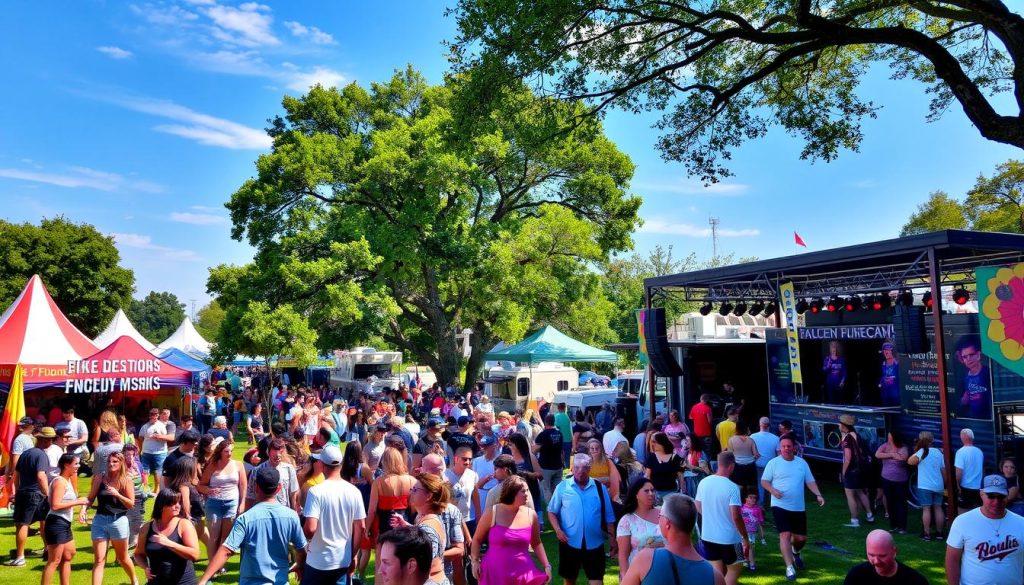
Natural Attractions and Weather Impact
Austin’s outdoor attractions change with the city’s weather patterns. The famous Barton Springs Pool stays at 68-70°F all year. It’s a favorite spot for both visitors and locals.
The Lady Bird Johnson Wildflower Center shines in spring. That’s when the nature spots burst with wildflowers. It’s a colorful and fragrant place to explore.
Lake Travis and other lakes are great for summer fun. But, drought can make them hard to reach and lower the water levels. The area’s limestone geology creates unique natural features and water sources. These shape the landscape and the fun activities for visitors.
- Barton Springs Pool maintains a constant temperature year-round, making it a popular year-round destination.
- The Lady Bird Johnson Wildflower Center is best visited in spring for the stunning wildflower displays.
- Lake Travis and other water bodies are affected by drought conditions, impacting summer recreation.
- The limestone geology of the area contributes to the formation of unique natural features and water sources.
“Austin’s natural wonders are as diverse as the weather that shapes them, offering visitors a truly unique and unforgettable experience.”
Conclusion
Your journey through Austin’s weather has shown you the city’s true heart. Spring brings vibrant blooms, summer is hot, autumn is cool, and winters are mild. Austin’s weather shapes your travel experience.
Knowing the seasons helps you plan your trip. You can enjoy the city’s weather-dependent spots, events, and outdoor fun. This way, you make the most of your time in Austin.
Austin’s weather is key to exploring its lively music, tech scene, and nature. The best times to visit are March and October. But, always be ready for storms.
As you leave Austin, remember its weather shows its strength and flexibility. The city faces challenges like flash floods and droughts. Yet, its people and visitors stay resilient.
By embracing Austin’s seasons and planning well, you’ll have an unforgettable trip. In the heart of Austin travel, weather planning and seasonal recommendations come together for a great journey.
